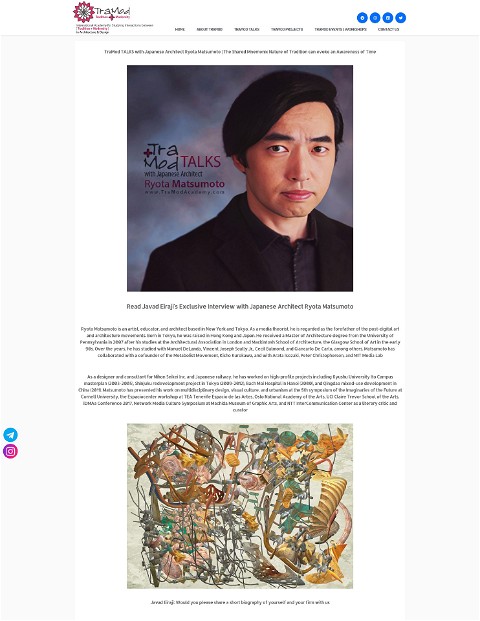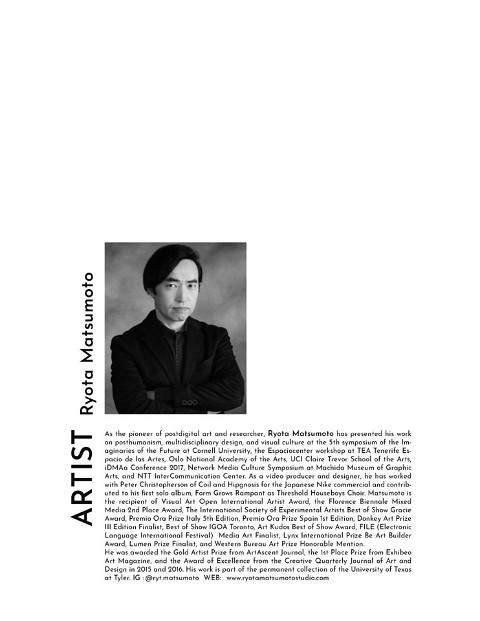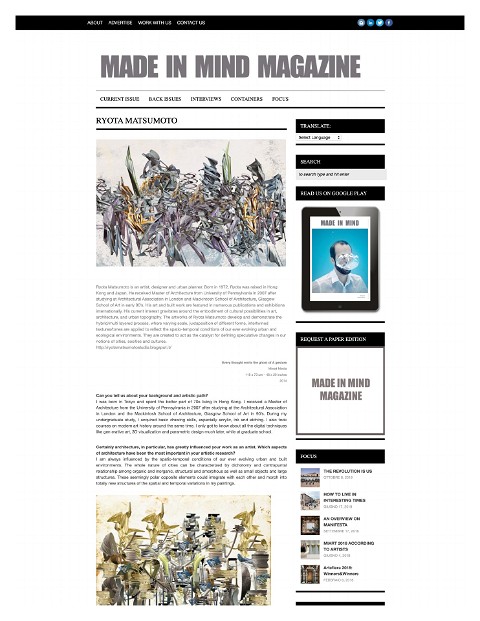松本良多 - アートと建築 | Faburry Gallery 2016
>100 Views
November 27, 23
スライド概要
松本良多は東京出身のニューヨークを拠点として活動するアーティスト、建築デザイナー、アーバンプランナー、教育者。
10代を香港とマンハッタンで過ごした後、ロンドンのAAスクール、グラスゴー美術大学、マイアミ大学にて建築と哲学を学び、2007年ペンシルベニア大学大学院芸術学部建築学科を首席で卒業する。マニュエル・デランダ、ヴィンセント・ジョゼフ・スカーリー、セシル・バルモンド、 ジャンカルロ・デ・カルロに師事する。
90年代よりMITメディアラボ、磯崎新、黒川紀章、インダストリアル・ミュージックの先駆者、ピーター・クリストファーソンと協働し、ベトナムバクマイ病院、九州大学センター地区のマスタープランをはじめ多数の建築、都市計画、アートのプロジェクトを手掛ける。ポーランドのシレジア大学の講師を経て、2016年よりプリマス大学 Transart Instituteの客員教授に就任、クーパー・ユニオン、プラット・インスティテュート、コーネル大学、ニューセンター・オブ・リサーチ・アンド・プラクティス シアトル校にてゲストレクチャラーとして教鞭をとっている。シカゴ市文化庁客員キュレーター、英国美術協会 (British Art Network) 名誉会員。
オスロ国立美術大学、カリフォルニア大学アーバイン校、テネリフェ市立美術館にて加速主義、ポストヒューマニズムについて講演している。2017年にはレバーヒューム・トラスト国際学会の招聘によりコーネル大学にて「ポストヒューマニズムと未来都市」について講演する。2019年にはロンドンICAにて「トランスヒューマン社会と生成の唯物論」のレクチャーをキュレート、2020年以降はロージ・ブライドッティとのクリティカル・ヒューマニズムについての講義、エドワード・カックとのカリフォルニア大学アーバイン校でのワークショップと多岐な分野で活動している。
ハイブリッド・アートとアルゴリズミック・コンピュテーションの手法を応用したメディア・アートの作品のインターナショナルな評価によりFILE(Electronic Language International Festival)Prix Lux Finalist、英国 Visual Art Open International Artist Awardを受賞する。
2016年には日本人として初めてイタリアとスペインからPremio Ora賞を同時に受けて2015年、2016年、2017年にロサンゼルスのLos Angeles Center for Digital Art、BYTE Gallery トランスベニア大学、ArtSpace ペスカラにて個展を開催する。2018年、韓国国立中央博物館の招聘展、テキサス大学、 ロサンゼルス現代美術館の常設展示作品のアーティストに選ばれている。
関連スライド
各ページのテキスト
July 2016 Exhibition — Faburry Gallery 2016/08/02 2:26 JULY 2016 EXHIBITION HOME INTERVIEWS SUBMIT PROMOTE A FRIEND ABOUT RYOTA MATSUMOTO Matsumoto’s work reflects the morphological transformations of our ever-evolving urban and ecological milieus, which could be attributed to a multitude of spatio-temporal phenomena influenced by social, economic and cultural factors. They are created as visual commentaries on speculative changes in notions of socities, cultures and ecosystems in the transient nature of constantly shifting topography and geology. The artworks explore the hybrid technique combining both traditional media (ink, acrylic, and graphite) and digital media (algorithmic processing, parametric modeling, data transcoding and image compositing with custom software ). The varying scale, juxtaposition of structural and amorphous forms, intertwined textures, oblique projections and visual metamorphoses are employed as the multi-layered drawing methodologies to question and investigate the ubiquitous nature of urban meta-morphology, the Anthropocene, and their visual representation in the context of nonEuclidean configuration. Furthermore, the application of these techniques allow the work to transcend the boundaries between analog and digital media as well as between twoand multi-dimensional domains. His compositional techniques imbue the work with what we see as the very http://www.faburrygallery.com/julyexhibition/#/nebel/ 1/3 ページ
July 2016 Exhibition — Faburry Gallery 2016/08/02 2:26 essence of our socio-cultural environments beyond the conventional protocols of architectural and artistic formalities, and that they conjure up the synthetic possibilities within which the spatial and temporal variations of existing spatial semiotics emerge as the potential products of alchemical procedures. Read Interview Back to July 2016 Exhibition prev / next MICHELE KISHITA JESSICA BRILLI APRIL ZANNE JOHNSON SUSAN CARR RICHARD GIANNOTTI REBECCA CHITTICKS http://www.faburrygallery.com/julyexhibition/#/nebel/ 2/3 ページ
- http://www.faburrygallery.com/julyexhibition/#/nebel/
- http://www.faburrygallery.com/artists/2016/7/6/ryota-matsumoto
- http://www.faburrygallery.com/julyexhibition/#
- http://www.faburrygallery.com/michelekishita/
- http://www.faburrygallery.com/weite/
- http://www.faburrygallery.com/aprilzannejohnson/
- http://www.faburrygallery.com/susancarr/
- http://www.faburrygallery.com/maritime/
- http://www.faburrygallery.com/weg/
July 2016 Exhibition — Faburry Gallery 2016/08/02 2:26 ERIKA STEARLY MARIE TOSTO JENNY BROWN RYOTA MATSUMOTO Terms and Condition Privacy Policy http://www.faburrygallery.com/julyexhibition/#/nebel/ 3/3 ページ
- http://www.faburrygallery.com/julyexhibition/#/nebel/
- http://www.faburrygallery.com/erikastearly/
- http://www.faburrygallery.com/marietosto/
- http://www.faburrygallery.com/jennybrown/
- http://www.faburrygallery.com/nebel/
- http://www.faburrygallery.com/terms-and-conditions
- http://www.faburrygallery.com/privacy-policy
Ryota Matsumoto — Faburry Gallery 2016/08/02 2:27 JULY 2016 EXHIBITION HOME INTERVIEWS SUBMIT PROMOTE A FRIEND ABOUT LATEST POSTS MICHELE KISHITA Jul 11, 2016 ERIKA STEARLY Jul 11, 2016 JENNY BROWN Jul 11, 2016 JESSICA BRILLI Jul 11, 2016 APRIL ZANNE JOHNSON Jul 11, 2016 RYOTA MATSUMOTO SUSAN CARR Jul 11, 2016 July 11, 2016 Matsumoto’s work reflects the morphological transformations of our ever-evolving urban and RICHARD GIANNOTTI Jul 11, 2016 ecological milieus, which could be attributed to a multitude of spatio-temporal phenomena influenced by social, economic and cultural factors. They are created as visual commentaries REBECCA CHITTICKS on speculative changes in notions of socities, cultures and ecosystems in the transient nature Jul 11, 2016 of constantly shifting topography and geology. The artworks explore the hybrid technique combining both traditional media (ink, acrylic, and MARIE TOSTO Jul 11, 2016 graphite) and digital media (algorithmic processing, parametric modeling, data transcoding and image compositing with custom software ). The varying scale, juxtaposition of structural and amorphous forms, intertwined textures, RYOTA MATSUMOTO Jul 11, 2016 oblique projections and visual metamorphoses are employed as the multi-layered drawing methodologies to question and investigate the ubiquitous nature of urban meta-morphology, the Anthropocene, and their visual representation in the context of non-Euclidean configuration. Furthermore, the application of these techniques allow the work to transcend the boundaries between analog and digital media as well as between two- and multidimensional domains. His compositional techniques imbue the work with what we see as the very essence of our socio-cultural environments beyond the conventional protocols of architectural and artistic formalities, and that they conjure up the synthetic possibilities within which the spatial and http://www.faburrygallery.com/artists/2016/7/6/ryota-matsumoto 1/4 ページ
- http://www.faburrygallery.com/artists/2016/7/6/ryota-matsumoto
- http://www.faburrygallery.com/artists/2016/6/26/michele-kishita
- http://www.faburrygallery.com/artists/2016/6/26/erika-stearly
- http://www.faburrygallery.com/artists/2016/7/4/jenny-brown
- http://www.faburrygallery.com/artists/2016/7/4/jessica-brilli
- http://www.faburrygallery.com/artists/2016/7/4/april-zanne-johnson
- http://www.faburrygallery.com/artists/2016/7/5/susan-carr
- http://www.faburrygallery.com/artists/2016/7/5/richard-giannotti
- http://www.faburrygallery.com/artists/2016/7/5/rebecca-chitticks
- http://www.faburrygallery.com/artists/2016/7/5/marie-tosto
- http://www.faburrygallery.com/julyexhibition/
- http://www.faburrygallery.com/
- http://www.faburrygallery.com/artists/
- http://www.faburrygallery.com/submit/
- http://www.faburrygallery.com/friends/
- http://www.faburrygallery.com/about-1/
Ryota Matsumoto — Faburry Gallery 2016/08/02 2:27 temporal variations of existing spatial semiotics emerge as the potential products of alchemical procedures. Ryota Matsumoto is a principal and founder of an award-winning interdisciplinary design office, Ryota Matsumoto Studio based in Tokyo. He is an artist, designer and urban planner. He received a Master of Architecture degree from University of Pennsylvania in 2007 after his studies at Architectural Association in London and Mackintosh School of Architecture, Glasgow School of Art in early 90’s. He currently serves as an advisor and adjunct faculty member of Transart Institute in Berlin and New York. His art and design work are featured in numerous publications and exhibitions worldwide. http://www.ryotamatsumoto.com You have successfully mastered multiple creative fields: art, design and architecture. Tell us about how you balance all three interests. It seems to me the boundaries between art and design disciplines are no longer of any significance and they tend to blur more often than not. As far as my personal experience as a designer is concerned, we tend to work as a bridging point among various disciplines. From our formative years, we are trained to pick things up quickly from different fields and apply them to resolve any emerging issues. In that respect, interdisciplinary thinking comes naturally to me and I always find the way to break down barriers between fields rather than balancing between them to cultivate common ground, even when I am engaged in art or design-related fields. How do you manage your time in the studio? What is your best advice for maximizing your schedule? I firmly believe that creativity comes out of a whirlpool of chaos. So what I always do is jotting down or drawing whatever pops into my head. Then I create associations among random words or drawings. It is probably similar to surrealists’ exquisite corpse in terms of a creative process. It allows you to take up any mundane ideas and to turn them into something inventive in spite of your limited time and tight schedule. To me, maximizing schedule is tantamount to seeking effective ways to think outside the box. Explain the process behind your paintings. What inspires you? My blended background in architecture and visual art leads me to explore the hybrid approach, whereby I combine the traditional media (ink, acrylic, and graphite) and digital media (algorithmic processing, parametric modeling, generative design, data transcoding and image compositing with custom software ). The technique allows me to instill a warm human touch and painterly, organic feels to otherwise cold and detached precision of digital drawings. I am deeply affected by the deterioration and transformation of our urban and ecological milieus that are often attributed to emerging realities of the Anthropocene, the gamut of environmental issues, and the multitude of spatial practices constructed by different societies over centuries. These agendas are what I would like to address through my work and interdisciplinary research. How much planning does each work require? I don’t plan much beforehand. I prefer to take an unexpected trip that might lead me down an unpredictable path. Spontaneity is a crucial element to keep the tension and freshness in my work, especially when I work with digital media which is often associated with formalistic rigidity. http://www.faburrygallery.com/artists/2016/7/6/ryota-matsumoto 2/4 ページ
Ryota Matsumoto — Faburry Gallery 2016/08/02 2:27 What are your favorite activities when you are not working? I like to travel a lot, discover a new place and meet people from a different cultural and professional background, whenever time allows. I never have chance to settle down and live a life of constant travel since my childhood. So far, this lifestyle proves to be a great learning experience. What advice would you give artists for promoting their work ? I, myself am still searching for the way to promote my work. I gather online galleries and social networking sites have the potential to not only promote the work of emerging talents but facilitate interaction, communication, and collaboration especially among multimedia artists. Share 0 Likes ← Marie Tosto http://www.faburrygallery.com/artists/2016/7/6/ryota-matsumoto 3/4 ページ





